Fix: Windows 10 Stuck on Restarting
There is a well-known problem for Windows 10 users where their computer gets stuck on the restart screen for a specific period of time. The rotating ball symbolizing processing and the restarting is seen on the screen for as long as 4-5 minutes.
This can be caused due to a number of reasons. It isn’t safe to say that this problem is caused by only one problem. We have populated a list of different solutions. Go through them starting from the topmost to fix your error in no time.
Solution 1: Disabling Fast Startup
Windows 10’s Fast Startup (also called fast boot) works similarly to the hybrid sleep modes of previous versions of windows. It combines the elements of a cold shutdown and the hibernate feature. When you shut down your computer, Windows logs off all users and closes all applications similar to the cold boot. At this point, Window’s state is similar to when it is freshly booted up (as all users are logged off and applications are closed). However, the system session is running and the kernel is already loaded up.
Then Windows sends a notification to device drivers to prepare for hibernation and saves the current system state to hibernation and turns off the computer. When you restart the computer, Windows doesn’t have to reload the kernel, system state or the drivers. It just refreshes your RAM with the loaded image in the hibernation file and navigates you to the startup screen.
This feature makes Windows boot faster so you don’t have to wait the traditional time. However, this feature is also known to cause problems by getting stuck in the restart loop. Furthermore, the Windows updates might not get installed properly as they require your computer to completely shut down. Follow the instructions to disable the fast boot option.
- Press Windows + R to launch the Run application. In the dialogue box type “control panel” and hit Enter. This will launch your computer’s control panel.
- Once in the control panel, click on Power Options.

- Once in the Power Options, click on “Choose what the power buttons do” present at the left side of the screen.

- Now you will see an option which requires administrative privileges named as “Change Settings that are currently unavailable”. Click it.

- Now head to the bottom of the screen and uncheck the box which says “Turn on fast startup”. Save changes and exit.

- You might need to restart your computer. Check if the problem at hand got fixed.
Solution 2: Disabling Geolocation, Cryptographic and Selective Startup
Many users reported that disabling the geographic and cryptographic services made their problem go away. Geographic services are services which help your PC track itself using geographic coordinates. This is also one of the main services which help any external program or website determine your location.
Cryptographic services provide management services and allow new programs to be installed on your computer while also confirming the signature of windows on different applications.
- Press Windows + R to launch the Run application. Type “msconfig” and press Enter.
- Now navigate to the General tab and select the option of Diagnostic startup.
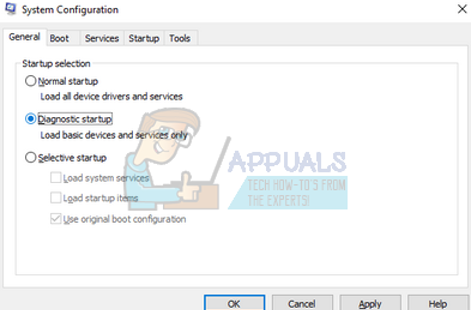
- Press Apply to save changes and exit.
- Press Windows + R to launch the Run application. Type “services.msc” and press Enter. Now a new window will open consisting of all the services location on your computer.
- Browse through the list until you find “Cryptographic Services”. Double-click it to open its menu.
- Now navigate to the General tab. Click on the button of “Stop” present under the subheading of Service status. Once you have stopped the service, click on “Startup type” and select Disabled from the drop-down menu.
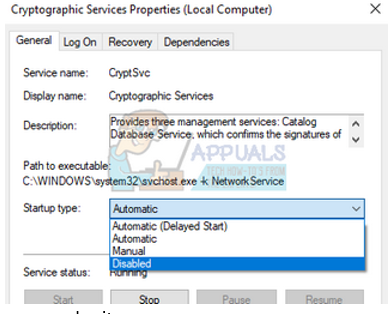
- Press Ok to save changes and exit.
- Browse through the list until you find “Geolocation Service”. Double-click it to open its menu.
- Now navigate to the General tab. Click on the button of “Stop” present under the subheading of Service status. Once you have stopped the service, click on “Startup type” and select Disabled from the drop-down menu.
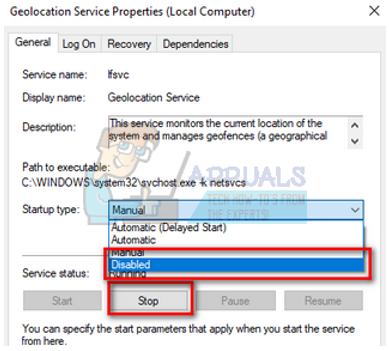
Now try restarting your computer and check if the problem gets solved. If there was no change in the delay time, try changing the startup type to Normal startup. If all this still doesn’t bring any improvement, you can always revert back the changes we made.
Solution 3: Updating your BIOS
BIOS stands for Basic Input/Output System and it is a firmware used to perform the hardware initialization during the booting process of your computer. The BIOS system is preinstalled on your computer by your manufacturer and it is the first software that runs when your computer is started up. It is more like a key which starts all other processes on your computer.
The BIOS is also responsible to test hardware components on your PC and make sure that they are working properly without any errors. Most of the BIOS are designed specifically to work with a specific model or motherboard. Traditionally, BIOS was written on ROM and hardware needed to be replaced when updating the BIOS. In modern computer systems, BIOS is stored in flash memory so it can be rewritten without the menace of replacing the hardware.
There was positive feedback from the users that updating their BIOS resolved the problem of their computer being stuck at the restart screen.
You can read our articles on how to update the BIOS of an HP Desktop/Laptop, a Gateway Desktop/Laptop, a Lenovo machine, an MSI motherboard and of a Dell Desktop/Laptop.
Solution 4: Updating your Drivers
Outdated, broken or incompatible drivers also often cause the problem. After your upgrade to Windows 10, the device drivers may not be installed properly or they might not be configured as expected. We can try updating the all the drivers automatically using the Windows Update.
If you still don’t get the desired drivers installed, we can manually install the drivers after downloading them from the manufacturer’s site.
- Press Windows + R to launch the Run Type “devmgmt.msc” in the dialogue box and hit Enter. This will launch your computer’s device manager.
- Here all the installed devices against your computer will be listed. Navigate through all the devices and update the display/graphics drivers. You should check updates for all the drivers present on your computer.
Note: We are showing you how to update your display drivers as an example. Use this method to update all the drivers on your computer.
- Click on the Display adapters dropdown to see your installed display card. Right click on it and select “Update driver”.
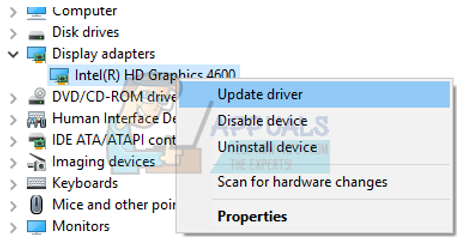
- Now Windows will pop a dialogue box asking you which way do you want to update your driver. Select the first option (Search automatically for updated driver software) and proceed. If you are unable to update the drivers, you can head over to your manufacturer’s site and install them manually.
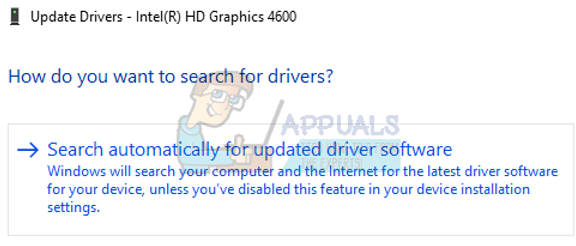
- Update all your drivers before restarting your computer and checking if the problem got fixed
Solution 5: Unplugging all USB/Consoles from your Computer
You can try unplugging all the externally connected devices from your computer and check if this brings any improvement. As we all know, Windows tend to stop these devices properly until it proceeds with the restart or a shutdown. It is possible that these devices refuse to respond to the requests made by the computer to stop properly.
This might be the case why the computer takes a lot of time in the restart process. Unplug all externally connected devices such as USB, consoles etc.
Solution 6: Deleting the contents of SoftwareDistribution
There is also a possibility that there are some files corrupt on your computer which causes your computer to take a lot of time while restarting. Corrupt files can occur due to a number of reasons. Sometimes one software conflicts with another and some wrong overwriting can corrupt files. We will try entering the safe mode for your windows and carry out the operations required in that mode.
- Follow the instructions on our article on how to boot your computer in safe mode.
- Press Windows + S to launch the search bar of your start menu. Type command prompt, right click on the first result which comes forth and select “Run as administrator”.
- Type “net stop wuauserv” and press Enter. This command will stop the update process running in the background.
- Now type “cd %systemroot%”. This command will navigate your command prompt to the installation directory of your Windows operating system.

- Now type “ren SoftwareDistribution SD.old”. This command will rename your SoftwareDistribution folder to SD.old. By doing this, the computer will not find the SoftwareDistribution folder and will be forced to make a new one. You can always navigate to the file directory and backup the folder in case anything goes wrong.

- Lastly, type “net start wuauserv”. This will enable the update service back on. Now restart your computer and check if this solution yielded any results.
Solution 7: Checking for failed processes or applications
You can check if there are any programs which are hanging or failing to stop properly thus causing your computer to get stuck on the restart screen.
Once you have successfully pinpointed the application which is causing you problems, you can uninstall it using the instructions given below.
- Press Windows + R button to launch the Run application. Type “control panel” and hit Enter.
- Once in the control panel, click on “Uninstall a program” found under the title of Programs and Features.
- Now Windows will list all the installed programs in front of you. Navigate through them until you find the program which is causing you problems.

- Once it is uninstalled, restart your computer and check if this fixed your problem.
Solution 8: Checking your Firewall and Antivirus
We can try disabling your Firewall and check if the restart procedure. Windows Firewall monitors your incoming and outgoing internet data and packets. It also blocks some connections or some applications from installation if they don’t fulfill its criteria.
- Press Windows + R button to bring up the Run application. In the dialogue box type “control”. This will open your computer’s control panel in front of you.
- In the top right there will be a dialogue box to search. Write firewall and click on the first option that comes as a result.

- Now at the left side, click the option which says “Turn Windows firewall on or off”. Through this, you can turn your firewall off easily.
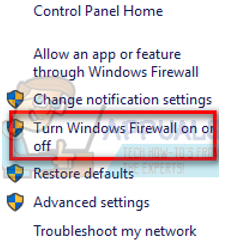
- Select the option of “Turn on Windows Firewall” on both the tabs, Public and Private Networks. Save changes and exit. Restart your computer and check if the problem gets resolved.
Solution 9: Disconnect from your Network
Many users reported that the connection to their LAN or WiFi network was causing a problem. This seems to be a bug in Windows 10. You should disconnect from your network before restarting and check if the process goes more smoothly.
- Press the network icon present at the bottom right side of the screen.
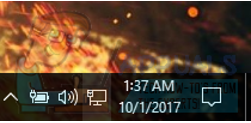
- Now disconnect your WiFi and your Ethernet accordingly.
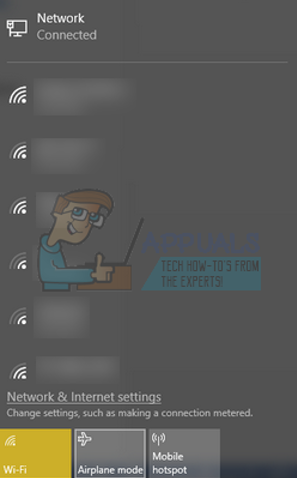
- Restart your computer and check if the problem gets solved.
Solution 10: Install the latest Windows updates
Windows roll out important updates targeting the bug fixes in the operating system. If you are holding back and not installing the Windows update, we strongly recommend that you do. Windows 10 is the latest Windows operating system and new operating systems take a lot of time to get perfect in every regard.
There are a lot of issues still pending with the OS and Microsoft rolls out frequent updates to target these issues.
- Press Windows + S button to launch your start menu’s search bar. In the dialogue box type “Windows update”. Click the first search result which comes forward.

- Once in the update settings, click on the button which says “Check for updates”. Now Windows will automatically check for the updates available and install them. It may even prompt you for a restart.
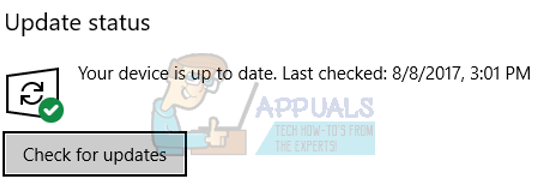
- After updating, check if your issue got fixed.
Note: If your computer is stuck at the restarting window and you can’t get further, hold your power button for a couple of seconds to shut it down. If this doesn’t work, unplug the power supply of your computer. If you have a laptop, take out the battery and wait a couple of minutes before plugging it back in.